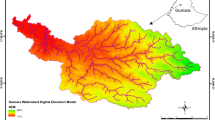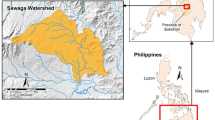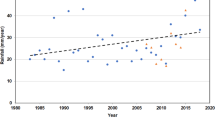Abstract
Absence of reliable hydro-climatic information is among the bottlenecks for inadequate and improper management of stormwater runoff in rapidly-urbanizing catchments. This paper explores the influence of catchment heterogeneity in understanding the proneness of urban catchments to stormwater-borne hazards. Using GIS techniques, satellite images, and field surveys, geomorphological features and hydrologic characteristics of the Mbezi River catchment in Dar es Salaam-Tanzania were modeled to understand variations in their influence on flood hazards occurrence throughout the study catchment. The findings reveal that with GIS techniques public, domain Digital Elevation Models (DEMs) can provide preliminary but useful insights to inform stormwater management decisions in cities with limited hydrological data. Specifically, the heterogeneity characterization of the case study catchment indicates that Mbezi River is fern-leaf-shaped: it has a well-drained catchment (drainage density = 1.9 km/km2), with total relief and elongation ratios of 265 m and 0.25, respectively. Results further revealed that the catchment is comprised of many natural sinks (blue spots) that, upon enhancement, can retain about 18 percent of stormwater runoff that could otherwise contribute to downstream runoff challenges. About 68 percent of the major sinks (with potential volume > 2.4 m3) are located along the river flood plain where land is publicly owned. Additionally, more than 11.6 ha of land (as property) and 168 buildings are in areas that were mapped to have large natural sinks and they are at risk to flooding when the sinks get filled.
Similar content being viewed by others
References
Apel H, Aronica G, Kreibich H, Thieken A (2009). Flood risk analyses—how detailed do we need to be? Nat Hazards, 49(1): 79–98
Baby S N, Arrowsmith C, Liu G J, Mitchell D, Al-Ansari N, Abbas N (2021). Finding areas at risk from floods in a downpour using the Lidar-based elevation model. J Civil Eng Archit
Ballesteros Cánovas J, Eguibar M, Bodoque J, Díez-Herrero A, Stoffel M, Gutiérrez-Pérez I (2011). Estimating flash flood discharge in an ungauged mountain catchment with 2D hydraulic models and dendrogeomorphic palaeostage indicators. Hydrol Processes, 25(6): 970–979
Balstrøm T, Crawford D (2018). Arc-Malstrøm: a 1D hydrologic screening method for stormwater assessments based on geometric networks. Comput Geosci, 116: 64–73
Betson R P (1964). What is watershed runoff? J Geophys Res, 69(8): 1541–1552
Beven K J (2011). Rainfall-Runoff Modelling: the Primer. New York: John Wiley & Sons
Blöschl G (2005). Rainfall-runoff modeling of ungauged catchments. In: Anderson M G, ed. Encyclopedia of Hydrological Sciences. New York: John Wiley & Sons
Chadha D K, Neupane B R(2011). Significance of Geomorphic Analysis of Watershed for Optimization of Recharge Structures. UNESCO
Chen J, Hill A A, Urbano L D (2009). A GIS-based model for urban flood inundation. J Hydrol (Amst), 373(1–2): 184–192
Debo T N, Reese A (2003). Municipal Stormwater Management. CRC Press
Dhalla S, Zimmer C (2010). Landscape-Based Stormwater Managment Manual. Toronto: Toronto and Region Conservation Authority
Dunne T, Whipple K X, Aubry B F (1995). Microtopography of hillslopes and initiation of channels by Horton overland flow. In: Costa J E, Miller A J, Potter K W, Wilcock P R, eds. Natural and Anthoropogenic Influenes in Fluvial Geomorphology. Geophys Monogr Am Geophys Un, 89: 27–44
Florinsky I, Skrypitsyna T, Luschikova O (2018). Comparative accuracy of the AW3D30 DSM, ASTER GDEM, and SRTM1 DEM: a case study on the Zaoksky testing ground, Central European Russia. Remote Sens Lett, 9(7): 706–714
Francis R A (2012). Positioning urban rivers within urban ecology. Urban Ecosyst, 15(2): 285–291
Furze S, Ogilvie J, Arp P A (2017). Fusing digital elevation models to improve hydrological interpretations. J Geogr Inf Syst, 9(5): 558–575
Ghimire B, Chen A S, Guidolin M, Keedwell E C, Djordjević S, Savić D A (2013). Formulation of a fast 2D urban pluvial flood model using a cellular automata approach. J Hydroinform, 15(3): 676–686
Gleyzer A, Denisyuk M, Rimmer A, Salingar Y (2004). A fast recursive gis algorithm for computing strahler stream order in braided and nonbraided networks 1. J Am Water Resour Assoc, 40(4): 937–946
Hewlett J D, Hibbert A R (1967). Factors affecting the response of small watersheds to precipitation in humid areas. Forest Hydrol, 1: 275–290
Justin M G, Bergen J M, Emmanuel M S, Roderick K G (2018). Mapping the gap of water and erosion control measures in the rapidly urbanizing Mbezi river catchment of Dar es Salaam. Water, 10(1): 64
Kherde R V (2016). Rainfall runoff modelling-modellers guide. Int J Appl Eng Res, 11(3): 1900–1907
Lee S, Yigitcanlar T (2010). Sustainable urban stormwater management: water sensitive urban design perceptions, drivers and barriers. In: Yigitcanlar T, ed. Rethinking Sustainable Development: Urban Management, Engineering, and Design. IGI Global, Engineering Science Reference, 26–37
Makungo R, Odiyo J, Ndiritu J, Mwaka B (2010). Rainfall-runoff modelling approach for ungauged catchments: a case study of Nzhelele River sub-quaternary catchment. Phys Chem Earth Parts ABC, 35(13–14): 596–607
Mason D C, Schumann G, Bates P (2011). Data utilization in flood inundation modelling. In: Pender G, Faulkner H, eds. Flood Risk Science and Management. New York: Wiley, 209–233
Mato R M (2002). Groundwater Pollution in Urban Dar es Salaam, Tanzania Assessing Vulnerability and Protection Priorities. Dissertation for Doctoral Degree. Eindhoven: Eindhoven University of Technology
Minea G (2013). Assessment of the flash flood potential of Bâsca River Catchment (Romania) based on physiographic factors. Cent Eur J Geosci, 5(3): 344–353
Mjemah I C, Walraevens K (2015). Hydrogeological mapping and estimation of potential evapotranspiration and recharge rate of Quaternary sand aquifers in Dar es Salaam, Tanzania. Int J Geomat Geosci, 6(2): 1539–1555
Pallard B, Castellarin A, Montanari A (2009). A look at the links between drainage density and flood statistics. Hydrol Earth Syst Sci, 13(7): 1019–1029
Papasaika H, Kokiopoulou E, Baltsavias E, Schindler K, Kressner D (2011). Fusion of digital elevation models using sparse representations. In: ISPRS Conference on Photogrammetric Image Analysis. Berlin: Springer
Parkinson J, Mark O (2005). Urban Stormwater Management in Developing Countries. IWA publishing
Saeedrashed Y, Guven A (2013). Estimation of geomorphological parameters of Lower Zab River-Basin by using GIS-based remotely sensed image. Water Resour Manage, 27(1): 209–219
Seo Y, Seo Y H, Kim Y O (2015). Behavior of a fully-looped drainage network and the corresponding dendritic networks. Water, 7(3): 1291–1305
Siart C, Bubenzer O, Eitel B (2009). Combining digital elevation data (SRTM/ASTER), high resolution satellite imagery (Quickbird) and GIS for geomorphological mapping: a multi-component case study on Mediterranean karst in Central Crete. Geomorphology, 112(1–2): 106–121
Sivapalan M, Takeuchi K, Franks S, Gupta V, Karambiri H, Lakshmi V, Liang X, McDONNELL J J, Mendiondo E M, O’Connell P E, Oki T, Pomeroy J W, Schertzer D, Uhlenbrook S, Zehe E (2003). IAHS Decade on Predictions in Ungauged Basins (PUB), 2003–2012: shaping an exciting future for the hydrological sciences. Hydrol Sci J, 48(6): 857–880
Spence C (2010). A paradigm shift in hydrology: storage thresholds across scales influence catchment runoff generation. Geogr Compass, 4(7): 819–833
Tavares da Costa R, Mazzoli P, Bagli S (2019). Limitations posed by Free DEMs in watershed studies: the case of river Tanaro in Italy. Front Earth Sci, 7: 141
Tetzlaff D, Carey S, Laudon H, McGuire K (2010). Catchment processes and heterogeneity at multiple scales—benchmarking observations, conceptualization and prediction. Hydrol Processes, 24(16): 2203–2208
Tian Y, Lei S, Bian Z, Lu J, Zhang S, Fang J (2018). Improving the accuracy of open source digital elevation models with multi-scale fusion and a slope position-based linear regression method. Remote Sens, 10(12): 1861
Wagener T, Wheater H, Gupta H V (2004). Rainfall-Runoff Modelling in Gauged and Ungauged Catchments. Singapore: World Scientific
Weitman D, Weinberg A, Goo R (2009). Reducing stormwater costs through LID strategies and practices. In: She N, Char M, eds. Low Impact Development for Urban Ecosystem and Habitat Protection. In: Proceedings of the 2008 International Low Impact Development Conference
Zhang S, Pan B (2014). An urban storm-inundation simulation method based on GIS. J Hydrol (Amst), 517: 260–268
Author information
Authors and Affiliations
Corresponding author
Rights and permissions
About this article
Cite this article
Mhina, G.J., Jensen, M.B. & Balstrøm, T. GIS-based flood proneness screening: a prelude to stormwater management in rapidly urbanizing catchments. Front. Earth Sci. (2021). https://doi.org/10.1007/s11707-021-0924-7
Received:
Accepted:
Published:
DOI: https://doi.org/10.1007/s11707-021-0924-7




